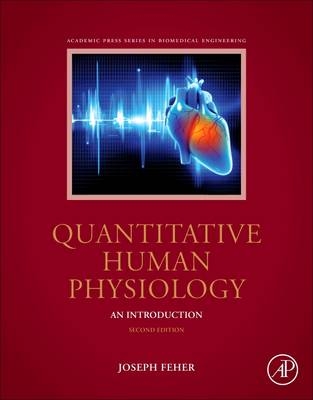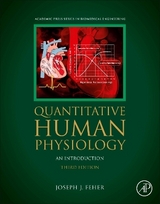
Quantitative Human Physiology
Academic Press Inc (Verlag)
978-0-12-800883-6 (ISBN)
- Titel erscheint in neuer Auflage
- Artikel merken
Dr. Joseph Feher is Professor Emeritus of Physiology and Biophysics at Virginia Commonwealth University. He received his Ph.D. from Cornell University, and has research interests in the quantitative understanding of the mechanisms of calcium uptake and release by the cardiac sarcoplasmic reticulum, in the mechanisms of calcium transport across the intestine, and in muscle contraction and relaxation. Dr. Feher developed a course in Introductory Quantitative Physiology for VCU’s College of Engineering, Department of Biomedical Engineering and has taught that course for over fifteen years. He also has taught muscle and cell physiology to medical and graduate students and has been Course Director for the Graduate Physiology survey course in physiology given at VCU’s School of Medicine.
Unit 1: Physical and Chemical Foundations of Physiology1.1. The Core Principles of Physiology1.2. Physical Foundations of Physiology I: Pressure-Driven Flow1.3. Physical Foundations of Physiology II: Electrical Force, Potential, Capacitance, and CurrentProblem Set 1.1. Physical Foundations: Pressure and Electrical Forces and Flows1.4. Chemical Foundations of Physiology I: Chemical Energy and Intermolecular Forces1.5. Chemical Foundations of Physiology II: Concentration and Kinetics1.6. Diffusion1.7. Electrochemical Potential and Free EnergyProblem Set 1.2. Kinetics and DiffusionUnit 2: Membranes, Transport, and Metabolism2.1. Cell Structure2.2. DNA and Protein Synthesis2.3. Protein Structure2.4. Biological MembranesProblem Set 2.1. Surface Tension, Membrane Surface Tension, Membrane Structure, Microscopic Resolution, and Cell Fractionation2.5. Passive Transport and Facilitated Diffusion2.6. Active Transport: Pumps and Exchangers2.7. Osmosis and Osmotic PressureProblem Set 2.2. Membrane Transport2.8. Cell Signaling2.9. ATP Production I: Glycolysis2.10. ATP Production II: The TCA Cycle and Oxidative Phosphorylation2.11. ATP Production III: Fatty Acid Oxidation and Amino Acid OxidationUnit 3: Physiology of Excitable Cells3.1. The Origin of the Resting Membrane Potential3.2. The Action Potential3.3. Propagation of the Action PotentialProblem Set 3.1. Membrane Potential, Action Potential, and Nerve Conduction3.4. Skeletal Muscle Mechanics3.5. Contractile Mechanisms in Skeletal Muscle3.6. The Neuromuscular Junction and Excitation–Contraction Coupling3.7. Muscle Energetics, Fatigue, and TrainingProblem Set 3.2. Neuromuscular Transmission, Muscle Force, and Energetics3.8. Smooth MuscleUnit 4: The Nervous System4.1. Organization of the Nervous System4.2. Cells, Synapses, and Neurotransmitters4.3. Cutaneous Sensory Systems4.4. Spinal Reflexes4.5. Balance and Control of MovementProblem Set 4.1. Nerve Conduction4.6. The Chemical Senses4.7. Hearing4.8. Vision4.2 Problem Set. Sensory Transduction4.9. Autonomic Nervous SystemUnit 5: The Cardiovascular System5.1. Overview of the Cardiovascular System and the Blood5.2. Plasma and Red Blood Cells5.3. White Blood Cells and Inflammation5.4. The Heart as a PumpProblem Set 5.1. Blood5.5. The Cardiac Action Potential5.6. The Electrocardiogram5.7. The Cellular Basis of Cardiac Contractility5.8. The Cardiac Function CurveProblem Set 5.2. Cardiac Work5.9. Vascular Function: Hemodynamics5.10. The Microcirculation and Solute Exchange5.11. Regulation of Perfusion5.12. Integration of Cardiac Output and Venous Return5.13. Regulation of Arterial PressureProblem Set 5.3. Hemodynamics and MicrocirculationUnit 6: Respiratory Physiology6.1. The Mechanics of Breathing6.2. Lung Volumes and Airway Resistance6.3. Gas Exchange in the LungsProblem Set 6.1. Airway Resistance and Alveolar Gas Exchange6.4. Oxygen and Carbon Dioxide Transport6.5. Acid–Base Physiology I: The Bicarbonate Buffer System and Respiratory Compensation6.6. Control of VentilationProblem Set 6.2. Gas Transport and pH DisturbancesUnit 7: Renal Physiology7.1. Body Fluid Compartments7.2. Functional Anatomy of the Kidneys and Overview of Kidney Function7.3. Glomerular FiltrationProblem Set 7.1. Fluid Volumes, Glomerular Filtration, and Clearance7.4. Tubular Reabsorption and Secretion7.5. Mechanism of Concentration and Dilution of Urine7.6. Regulation of Fluid and Electrolyte Balance7.7. Renal Component of Acid–Base BalanceProblem Set 7.2. Fluid and Electrolyte Balance and Acid–Base BalanceUnit 8: Gastrointestinal Physiology8.1. Mouth and Esophagus8.2. The Stomach8.3. Intestinal and Colonic Chemoreception and Motility8.4. Pancreatic and Biliary Secretion8.5. Digestion and Absorption of the Macronutrients8.6. Energy Balance and Regulation of Food IntakeProblem Set 8.1. Energy BalanceUnit 9: Endocrine Physiology9.1. General Principles of Endocrinology9.2. Hypothalamus and Pituitary Gland9.3. The Thyroid Gland9.4. The Endocrine Pancreas and Control of Blood Glucose9.5. The Adrenal Cortex9.6. The Adrenal Medulla and Integration of Metabolic Control9.7. Calcium and Phosphorus Homeostasis I: The Calcitropic Hormones9.8. Calcium and Phosphorus Homeostasis II: Target Tissues and Integrated Control9.9. Female Reproductive Physiology9.10. Male Reproductive PhysiologyProblem Set 9.1. Ligand Binding
| Erscheinungsdatum | 23.12.2016 |
|---|---|
| Reihe/Serie | Biomedical Engineering |
| Verlagsort | San Diego |
| Sprache | englisch |
| Maße | 216 x 276 mm |
| Gewicht | 2990 g |
| Themenwelt | Studium ► 1. Studienabschnitt (Vorklinik) ► Physiologie |
| ISBN-10 | 0-12-800883-0 / 0128008830 |
| ISBN-13 | 978-0-12-800883-6 / 9780128008836 |
| Zustand | Neuware |
| Haben Sie eine Frage zum Produkt? |
aus dem Bereich



